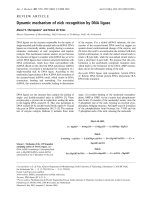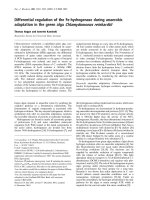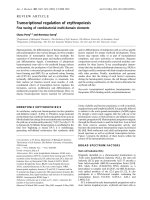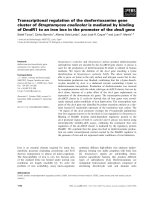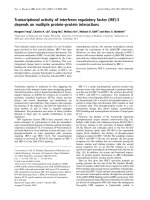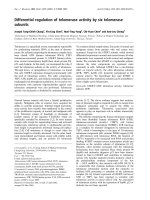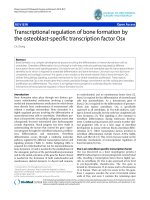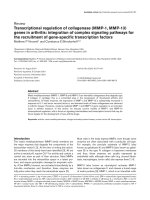Báo cáo y học: " Transcriptional regulation of metastatic [Id]entity by KLF17" pdf
Bạn đang xem bản rút gọn của tài liệu. Xem và tải ngay bản đầy đủ của tài liệu tại đây (318.63 KB, 3 trang )
Iwanicki and Brugge: Genome Biology 2009, 10:244
Abstract
A novel in vivo screening approach has identified KLF17 as a
key metastasis suppressor gene that acts through regulation of
Id1 transcription factor-dependent induction of the epithelial-to-
mesenchymal transition.
The development and growth of a malignant tumor relies
on molecular changes that affect the function of cellular
proto-oncogenes and tumor suppressors [1]. Certain
alterations are required constitutively during tumor initia-
tion and progression, whereas others are more speci fi cally
associated with aspects of tumor metastasis - the spread of
malignant cells to secondary tissues. Metastasis suppres-
sors are proteins that specifically repress events associated
with metastasis without affecting primary tumor growth
[2]. In a recent paper in Nature Cell Biology, Huang and
colleagues (Gumireddy et al. [3]) describe experiments
that identify a new metastasis suppressor, KLF17.
The course of metastasis
Progression towards metastatic disease involves a distinct
sequence of events. Tumor cells attract endothelial cells to
promote angiogenesis; dissociate from the primary tumor
mass and migrate towards endothelial cells; intravasate
through endothelial cells and the surrounding matrix; enter
the intra-tumoral vasculature; exit the vasculature at the
secondary sites; infiltrate the new environment; and
establish growing malignant colonies within a new organ [4].
These events are likely to be driven in large part by changes
in transcriptional programs that affect expression of genes
required for these processes (for example, genes that
promote angiogenesis, cell adhesion and matrix proteo lysis).
These transcriptional changes are mediated by alterations in
the tumor microenvironment [5] as well as by genetic
alterations in proto-oncogenes and tumor suppressors [6].
For example, many reports have shown that oncogenic
mutations in H-Ras or loss of p53 tumor suppressor function
induce trans criptional programs that promote metastasis
through altera tions in the expression of genes required for
the invasion of cancer cells into the surrounding tissues [4,7-
10]. Transcrip tion factors that promote the loss of epithelial
characteristics, such as (cell-to-cell) adhesion, have also been
proposed to play a key role in the initiation of metastasis.
The epithelial-to-mesenchymal transition (EMT) was
initially described as a fundamental process that drives
morphogenetic tissue movements in animal embryos [11].
Increasing evidence supports the hypothesis that epithelial
tumors adopt EMT-like characteristics during the invasion
of proximal tissues [12,13]. EMT involves the loss of apico-
basal epithelial cell polarity and the development of a
migratory polarity (leading edge and trailing edge) that
promotes migration [14].The molecular hallmarks of EMT
include the increased expression of transcription factors
that contribute to the loss of cell adhesion through the
downregulation of the cell adhesion molecule E-cadherin
and increased proteolysis of the surrounding extracellular
matrix as a result of the elevated expression of matrix
metalloproteinases [14]. Cells that have undergone EMT in
culture show an increased capability for invasive behavior
in vitro and in vivo [12].
Genome-wide screen for metastasis
suppressors
Gumireddy et al. [3] used a genome-wide screen to identify
genes that induce metastasis when their expression is
attenuated. Non-invasive mouse mammary tumor cells
were transduced with a genome-wide short hairpin RNA
(shRNA) library and implanted into mouse mammary fat
pads. Lung metastases that developed in these animals
were then analyzed by PCR for the most abundant shRNA
transcripts, one of which was found to target expression of
Krüppel-like transcriptional factor 17 (KLF17). Gumireddy
et al. [3] then found that shRNA-mediated attenuation of
KLF17 expression in the MCF-7 line of human non-
metastatic breast cancer cells promoted lung metastases in
mice into which the treated cells were introduced. In
addition, the overexpression of KLF17 in highly metastatic
4T1 mouse breast cancer epithelial cells decreased the
number of lung metastases in mice compared to control
cells. These experiments provide strong evidence that
KLF17 is a new metastasis suppressor gene.
KLF17 belongs to the Sp (small protein)/KLF zinc-finger
protein family. Other members of this family have been
shown to regulate cell invasion in vitro [15]. For example,
ectopic expression of KLF4 and/or KLF5 blocked the
invasive behavior of esophageal cancer cells in vitro [15].
Minireview
Transcriptional regulation of metastatic [Id]entity by KLF17
Marcin P Iwanicki and Joan S Brugge
Address: Department of Cell Biology, Harvard Medical School, 240 Longwood Avenue, Boston, MA 02115, USA.
Correspondence: Joan S Brugge. Email:
244.2
Iwanicki and Brugge: Genome Biology 2009, 10:244
However, the exact mechanisms by which these proteins
achieve their suppressive effect was not understood.
Gumireddy et al. [3] employed microarray analysis of
mRNAs in cells subjected to loss or gain of KLF17 expres-
sion to provide insights into the mechanisms by which KLF
family members suppress cell invasiveness and metastasis.
They show in particular that shRNA-mediated attenuation
of KLF17 levels in non-metastatic cells induces an EMT
‘signature’ of gene expression and increased expression of
inhibitor of differentiation-1 (Id1), which is known to be a
negative regulator of basic helix-loop-helix family trans-
cription factors and to be involved in promot ing EMT.
Conver sely, overexpression of KLF17 suppressed Id1 expres-
sion. The authors further show that KLF17 sup presses Id1
expression directly by binding to its promoter region. Id1
and KLF17 have opposite effects on a tumor’s ability to
metastasize. Primary tumor samples with high Id1 and low
KLF17 expression were highly metastatic, where as those
with higher expression of KLF17 and lower levels of Id1
were less metastatic. Taken together, these data support
the conclusion that Id1 plays a critical role in the regulation
of metastasis by KFL17.
Id1 and human cancer
ID1 is overexpressed in various human cancers, including
endometrial, ovarian, prostate and breast cancers [16], and
had previously been shown to promote invasion and
metastasis [10]. In tubular epithelial cells, ID1 was shown to
be required for transforming growth factor-β-mediated loss
of E-cadherin expression (a molecular hallmark of EMT)
[17]. ID1-mediated downregulation of E-cadherin occurs
through the direct binding of Id1 protein to the trans cription
factor HEB (HELA E-box binding factor), which prevents
HEB from accessing the E-cadherin promoter [17].
Interestingly, Gumireddy et al. [3] show that the loss of
KLF17 function in the NMuMg mouse mammary epithelial
cell line transformed by the oncogene V12H-Ras enhances its
capacity to produce lung metastases and drives metastasis to
several other organs. Given that V12H-Ras induces EMT
[18-20], these results suggest that processes in addition to
EMT contribute to the promotion of metastasis by Id1. For
example, Id1-induced metastasis could also involve tumor
vascularization, as Id1 promotes production of vascular
endothelial growth factor (VEGF) in prostate cancer cells
[21]. Taken together, these studies suggest a model in which
loss of KFL17 leads to induction of ID1, which could promote
primary tumor vascularization via VEGF production and
initiate invasion through EMT-associated processes,
including loss of E-cadherin adhesions and increased
activation of matrix metalloproteinases.
One important question raised by the work of Gumireddy
et al. [3] is whether the regulation of KLF17 is entirely
transcriptional or if its activity is also regulated post-
translationally, and what upstream factors control gene
expression or protein activity. The transcriptional activity
of Sp1/KLF family members has been shown to be
regulated post-translationally by phosphorylation [8,22]. A
search for phosphorylation-site motifs using Scansite [23]
predicts a high-stringency target site for phosphorylation
by protein kinase C-ε (PKCε) within the amino-terminal
region of KLF17. Given that the activity of some Sp1/KLF
family members is known to be regulated by PKC isoforms
[8,24-26], it is plausible that the ability of KLF17 to
suppress ID1 transcription could be either positively or
negatively tuned by some PKCs (Figure 1). However, future
experiments addressing the mechanisms of KLF17 regu la-
tion will be needed to fill this gap in our under standing of
metastatic progression.
The findings of Gumireddy et al. [3] highlight the
feasibility and the value of in vivo loss-of-function screens.
As the authors point out, these screens should be carried
out in models other than breast cancer, as distinct
transcription factors might play a role in the regulation of
invasion and metastasis in different cancer types.
Figure 1
Regulation of ID1 expression by KLF17. ID1 transcription is suppressed by KLF17 binding to the ID1 promoter. Loss of expression of KLF17
by transcriptional suppression or inactivation by post-translational modification (possibly by phosphorylation or dephosphorylation) leads to
transcription of ID1 through positive transcriptional regulators (shown in green) and induction of the multiple processes regulated by its
protein product, Id1.
KLF17
KLF17
ID1 promoter
KLF17
Transcriptional suppression
Protein phosphorylation
Protein dephosphorylation
ID1 mRNA
EMT
Tumor Angiogenesis
Invasion
Metastasis
X
244.3
Iwanicki and Brugge: Genome Biology 2009, 10:244
References
1. Fidler IJ: The pathogenesis of cancer metastasis: the ‘seed
and soil’ hypothesis revisited. Nat Rev Cancer 2003, 3:453-
458.
2. Smith SC, Theodorescu D: Learning therapeutic lessons
from metastasis suppressor proteins. Nat Rev Cancer 2009,
9: 253-264.
3. Gumireddy K, Li A, Gimotty PA, Klein-Szanto AJ, Showe LC,
Katsaros D, Coukos G, Zhang L, Huang Q: KLF17 is a nega-
tive regulator of epithelial-mesenchymal transition and
metastasis in breast cancer. Nat Cell Biol 2009, 11:1297-
1304.
4. Nguyen DX, Bos PD, Massague J: Metastasis: from dissemi-
nation to organ-specific colonization. Nat Rev Cancer 2009,
9: 274-284.
5. Kizaka-Kondoh S, Tanaka S, Harada H, Hiraoka M: The HIF-1-
active microenvironment: an environmental target for
cancer therapy. Adv Drug Deliv Rev 2009, 61:623-632.
6. Weinberg RA: Mechanisms of malignant progression.
Carcinogenesis 2008, 29:1092-1095.
7. Rak J, Mitsuhashi Y, Bayko L, Filmus J, Shirasawa S, Sasazuki
T, Kerbel RS: Mutant ras oncogenes upregulate VEGF/VPF
expression: implications for induction and inhibition of
tumor angiogenesis. Cancer Res 1995, 55:4575-4580.
8. Pal S, Datta K, Khosravi-Far R, Mukhopadhyay D: Role of
protein kinase Czeta in Ras-mediated transcriptional acti-
vation of vascular permeability factor/vascular endothelial
growth factor expression. J Biol Chem 2001, 276:2395-2403.
9. Wang SP, Wang WL, Chang YL, Wu CT, Chao YC, Kao SH,
Yuan A, Lin CW, Yang SC, Chan WK, Li KC, Hong TM, Yang
PC: p53 controls cancer cell invasion by inducing the
MDM2-mediated degradation of Slug. Nat Cell Biol 2009, 11:
694-704.
10. Fong S, Itahana Y, Sumida T, Singh J, Coppe JP, Liu Y,
Richards PC, Bennington JL, Lee NM, Debs RJ, Desprez PY:
Id-1 as a molecular target in therapy for breast cancer cell
invasion and metastasis. Proc Natl Acad Sci USA 2003, 100:
13543-13548.
11. Thiery JP: Epithelial-mesenchymal transitions in develop-
ment and pathologies. Curr Opin Cell Biol 2003, 15:740-746.
12. Polyak K, Weinberg RA: Transitions between epithelial and
mesenchymal states: acquisition of malignant and stem
cell traits. Nat Rev Cancer 2009, 9:265-273.
13. Mani SA, Guo W, Liao MJ, Eaton EN, Ayyanan A, Zhou AY,
Brooks M, Reinhard F, Zhang CC, Shipitsin M, Campbell LL,
Polyak K, Brisken C, Yang J, Weinberg RA: The epithelial-
mesenchymal transition generates cells with properties of
stem cells. Cell 2008, 133:704-715.
14. Friedl P, Wolf K: Tumour-cell invasion and migration: diver-
sity and escape mechanisms. Nat Rev Cancer 2003, 3:362-
374.
15. Yang Y, Goldstein BG, Chao HH, Katz JP: KLF4 and KLF5
regulate proliferation, apoptosis and invasion in esopha-
geal cancer cells. Cancer Biol Ther 2005, 4:1216-1221.
16. Perk J, Iavarone A, Benezra R: Id family of helix-loop-helix
proteins in cancer. Nat Rev Cancer 2005, 5:603-614.
17. Li Y, Yang J, Luo JH, Dedhar S, Liu Y: Tubular epithelial cell
dedifferentiation is driven by the helix-loop-helix transcrip-
tional inhibitor ID1. J Am Soc Nephrol 2007, 18:449-460.
18. Edme N, Downward J, Thiery JP, Boyer B: Ras induces NBT-II
epithelial cell scattering through the coordinate activities
of Rac and MAPK pathways. J Cell Sci 2002, 115:2591-2601.
19. Boyer B, Roche S, Denoyelle M, Thiery JP: Src and Ras are
involved in separate pathways in epithelial cell scattering.
EMBO J 1997, 16:5904-5913.
20. Larue L, Bellacosa A: Epithelial-mesenchymal transition in
development and cancer: role of phosphatidylinositol 3’
kinase/AKT pathways. Oncogene 2005, 24:7443-7454.
21. Ling MT, Lau TC, Zhou C, Chua CW, Kwok WK, Wang Q,
Wang X, Wong YC: Overexpression of Id-1 in prostate
cancer cells promotes angiogenesis through the activation
of vascular endothelial growth factor (VEGF). Carcino-
genesis 2005, 26:1668-1676.
22. Tan NY, Khachigian LM: Sp1 phosphorylation and its regula-
tion of gene transcription. Mol Cell Biol 2009, 29:2483-2488.
23. Scansite [ />24. Black AR, Black JD, Azizkhan-Clifford J: Sp1 and kruppel-like
factor family of transcription factors in cell growth regula-
tion and cancer. J Cell Physiol 2001, 188:143-160.
25. Kavurma MM, Santiago FS, Bonfoco E, Khachigian LM: Sp1
phosphorylation regulates apoptosis via extracellular
FasL-Fas engagement. J Biol Chem 2001, 276:4964-4971.
26. Tan NY, Midgley VC, Kavurma MM, Santiago FS, Luo X, Peden
R, Fahmy RG, Berndt MC, Molloy MP, Khachigian LM:
Angiotensin II-inducible platelet-derived growth factor-D
transcription requires specific Ser/Thr residues in the
second zinc finger region of Sp1. Circ Res 2008, 102:e38-
51.
Published: 30 November 2009
doi:10.1186/gb-2009-10-11-244
© 2009 BioMed Central Ltd
